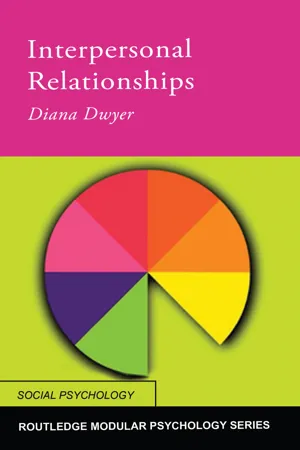Cultural Differences in Relationships
Cultural differences in relationships refer to the varying norms, values, and communication styles that exist across different cultures and can impact how individuals form and maintain relationships. These differences can influence aspects such as gender roles, conflict resolution, and expressions of love and affection, and understanding them is crucial for promoting healthy and successful cross-cultural relationships.
6 Key excerpts on "Cultural Differences in Relationships"
- eBook - ePub
- Donald Munro, John F. Schumaker, Stuart C. Carr, Donald Munro, John F. Schumaker, Stuart C. Carr(Authors)
- 2014(Publication Date)
- Routledge(Publisher)
...Finally, it is widely recognized by those outside the traditional academic boundaries of personal-relationship investigation that personal relationships play a strategic role in the wider issues of cultural change and political transition. It is thus evident that cross-cultural investigations of personal relationships are invaluable not only to those working within traditional psychology/sociology frameworks but also to those aiming at wider interdisciplinary connections within the social science and humanity disciplines. This chapter begins by looking at two theoretical approaches to the study of personal relationships across cultures. First, I consider sociobiological interpretations that stress the universality of relationship practices and beliefs, and some criticisms of this approach. I then outline work from a more social psychological tradition that emphasizes systematic differences in values across cultures and provide examples of the way in which studies of cultural variants can be used to understand some basic variations in personal relations across cultures. I also point to the way in which many of these values can be seen as transient and argue that relationship practices are in many ways at the forefront of cultural change and debate. For the sake of brevity, cross-cultural issues in polygamy and divorce are omitted; interested readers should consult the large anthropological data on this subject (e.g., Betzig, 1989 ; Goody, 1976). Arguing for Uniuersals: The Sociobiological Perspectiue The idea that there are fundamental psychological characteristics common to all humans is an old one; Jahoda (1990) traces it back at least as far as Condorcet (1743–94). In the past century, the work has been more empirically rigorous, with researchers having been intrigued by the prospect of finding cultural universals: worldwide patterns in language acquisition or facial expressions of emotion and so forth (Brown, 1991 ; Rohner, 1984)...
- Jane Jackson(Author)
- 2019(Publication Date)
- Routledge(Publisher)
...Compared with previous decades, intercultural relationships (e.g., friendships, dating, cohabitation, marriages involving people with a different cultural or religious background) have become much more commonplace and accepted in many parts of the world. Despite this, communication difficulties and other threats to these relationships still exist. Developing satisfactory intercultural bonds is believed by many to be more challenging than intracultural relationships (interpersonal bonds that form between individuals who share the same linguistic and cultural background) or intraracial relationships (interpersonal relationships between individuals from the same socially constructed racial group). Not all societies are receptive to intercultural relationships, especially when they are of an intimate or romantic nature. Negative reactions can certainly hamper or even prohibit intercultural unions. In addition to individual characteristics and skills, societal norms and attitudes can play a significant role in determining whether intercultural connections flourish or falter. Crossing boundaries in intercultural relationships Intercultural relationships can take many forms and cross one or more socially and historically constructed boundary (e.g., class, race, language, religion). People may develop affiliations with individuals from different ethnic, linguistic, national, racial, and religious backgrounds or form bonds with those who differ in terms of such dimensions as age, ability (e.g., linguistic, physical, mental), gender, social class, and sexual orientation. The following section briefly describes various types of intercultural relationships and provides examples of each. Interracial relationships As noted in previous chapters, ‘ race ’ is a culturally and historically transmitted concept...
- eBook - ePub
Foundations for Couples' Therapy
Research for the Real World
- Jennifer Fitzgerald, Jennifer Fitzgerald(Authors)
- 2017(Publication Date)
- Routledge(Publisher)
...In some places, these relationships were even against the law. However, in recent years the world’s population has become increasingly mobile and connected, and attitudes are changing. Rapid increases in intercultural marriage rates have been reported around the world. However, there is evidence that intercultural couples still face greater difficulties than intra-cultural couples. Intercultural couples are at higher risk of divorce than intra-cultural couples, and this risk increases with the extent of difference between the partners’ cultures (Kalmijn, de Graaf, & Janssen, 2005). Therefore, it is essential for couple therapists to acquire knowledge and skills to assist this growing population. Cultural Differences in Couple Relationships The dimensions of individualism and collectivism provide a simple framework via which cultural differences in couple relationships can be understood. In individualistic cultures, people are perceived as separate beings whose behaviour is primarily determined by internal attributes (Markus & Kitayama, 1991). Young people are expected to develop independence and discover and express their unique abilities, ideas, feelings and preferences. People are defined by their individual characteristics, and validation of these forms the basis of self-esteem. In contrast, in collectivistic cultures, people are defined by their relationships with others (Markus & Kitayama, 1991). Behaviour is determined by perceptions of others’ thoughts, feelings and actions, and self-esteem is derived from fitting harmoniously into the group. Suppression of individuality for the sake of group harmony is regarded as a sign of maturity. International studies indicate that European countries and former European colonies tend to be high in individualism, while Asian, African and Latin-American countries tend to be high in collectivism (see e.g., Hofstede, Hofstede, & Minkov, 2010). These cultural differences in values give rise to different relationship standards...
- eBook - ePub
- Diana Dwyer(Author)
- 2013(Publication Date)
- Routledge(Publisher)
...In the US, people view marriage as providing the opportunity to experience personal growth through the relationship and thereby achieve self-fulfilment (Dion and Dion, 1993). This can result in very unrealistic expectations and a lack of appreciation of how difficult marriage can be—a rather naive belief that ‘love conquers all’ (Heine and Lehman, 1995). Dion and Dion (1993) argue that some aspects of being socialised in an individualistic society make it very difficult to sustain a satisfactory marriage. Western culture, with its emphasis on the importance of independence, personal control and autonomy, makes it very difficult to maintain intimacy even though this is seen as the major goal of a successful marriage. Dion and Dion suggest that this may account for the high divorce rate in the US and Canada. In contrast, collectivist societies place great value on dependency on others and this is therefore a highly valued aspect of close relationships. Types of relationships studied Before leaving the topic of cross-cultural relationships, it is worth taking note of the comments made in Chapter 1 about the kinds of relationships that Western psychologists tend to study. In this chapter and in many of the previous ones, the focus has been on romantic relationships and friendship, reflecting the major topics researched in the area of interpersonal relationships. The emphasis is very firmly on first-time acquaintances, close personal friendships and intimate partnerships because these are considered to be the most important relationships in Western culture, with relatively little attention paid to kinship and community relations. As Moghaddam et al. (1993) comment, ‘The topic of interpersonal relationships provides an excellent example of how research topics reflect the characteristics of the societies from which they emerge’ (p. 94)...
- eBook - ePub
- (Author)
- 2020(Publication Date)
- Wiley-Blackwell(Publisher)
...This section emphasizes the role of culture, individual differences, and diversity considerations in couple assessment. We adopt the definition of culture from Haynes, Kaholokula, and Tanaka‐Matsumi (2018) and the Center for Advanced Research on Language Acquisition (CARLA, 2019) as “the shared patterns of behaviors and interactions, cognitive constructs, and affects that are learned through a process of socialization and that distinguish members of a group from members of another group.” Although the construct of culture is often associated with ethnicity, culture can also subsume multiple interacting and overlapping dimensions of diversity and individual differences such as race, gender and sex, religion/spirituality, sexual orientation, disability and economic status, age and occupation, and geographic location, among others. A focus on culture highlights the multidimensional complexity and importance of differences across persons in couple assessment. Consider the likely cultural differences between an older, economically secure, suburban‐dwelling, professional Asian American couple compared with a younger, economically disadvantaged, urban‐dwelling, nonprofessional European American couple. This one example invokes five dimensions of culture—and as many as 120 possible combinations of aspects of culture. Hence, one can readily discern the challenges that clinicians face in engaging in culturally sensitive couple assessment and in planning culturally sensitive interventions from the assessment data. Cultural considerations in couple assessment are important because culture can influence meaningful differences in couples' values, beliefs, expectations, goals, patterns of interaction, and the social and family context of the relationship (such as the role of a couple's extended family) (Haynes et al., 2018). The challenge is to use assessment methods and strategies and render clinical judgments that are culturally appropriate for each couple...
- eBook - ePub
- Miles Hewstone, Wolfgang Stroebe, Klaus Jonas, Miles Hewstone, Wolfgang Stroebe, Klaus Jonas(Authors)
- 2016(Publication Date)
- BPS Blackwell(Publisher)
...These variations can contribute to our understanding of the concept of culture if we take them into account. In the remainder of this chapter, we examine studies that are relevant to issues that have been discussed in preceding chapters, particularly in relation to social cognition, self-concept, personal relationships, group behaviour and intergroup relations. In each of these areas we will show how attention to cultural differences can enrich our understanding of social psychological processes. CULTURE AND CULTURAL DIFFERENCES What is culture and why should we study it? The opening chapter of this book discusses some of the best-known and frequently discussed social psychology experiments. Most of these experiments were conducted in the United States and some in the United Kingdom. What would happen if they were repeated somewhere else in the world? We can answer this question, because there have been attempts at cross-cultural replication of all these studies, some of them many times. Consider first an early study of group dynamics that was published by Schachter (1951). In this study, Schachter set up a series of student discussion groups. Unknown to most group members, each group contained an accomplice of the experimenter. The accomplice (the ‘deviate’) was instructed to take up a position opposed to the views of the majority and stick to his position. Schachter predicted that the deviate would over time receive less and less attention and be rejected by the group, which is just what he found among his US respondents. cross-cultural replication a test of whether the results of a study are the same if it is repeated as exactly as possible in another cultural context. A few years later, Schachter and seven colleagues (1954) reported on the results of a slightly different version of this study that was conducted in seven different European nations. In this case, groups of 11-year-old schoolboys were asked to decide which of several model aeroplanes to build...





